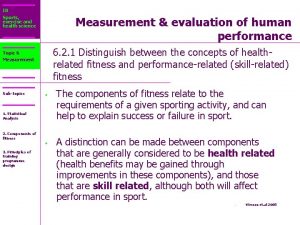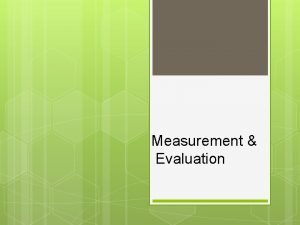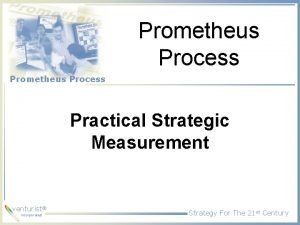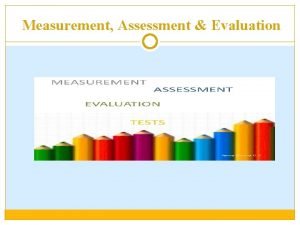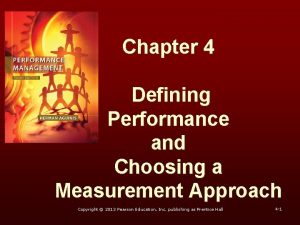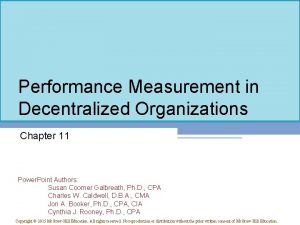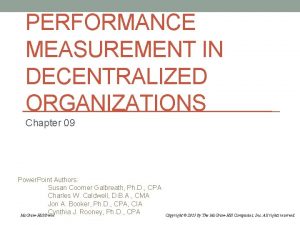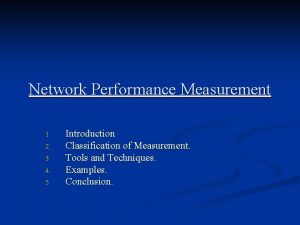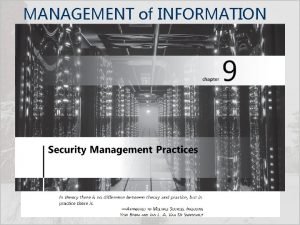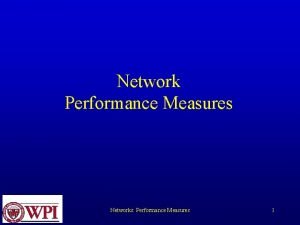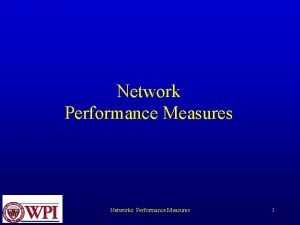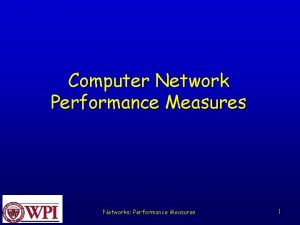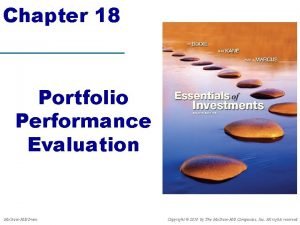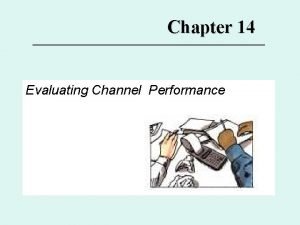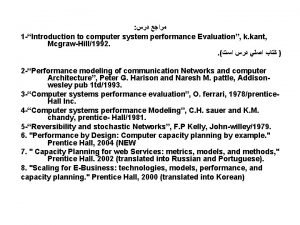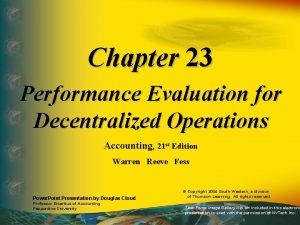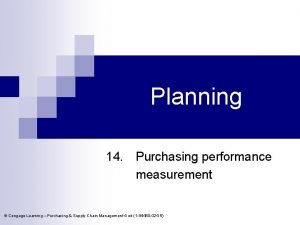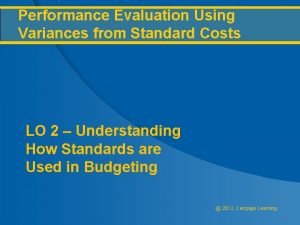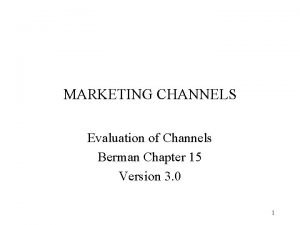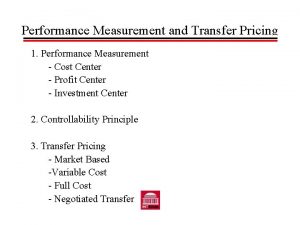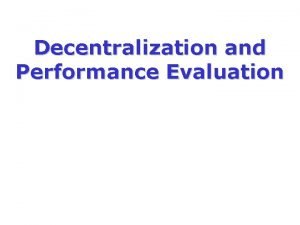Performance Evaluation Measurement and Management Laurinda Tran Linda






































- Slides: 38

Performance Evaluation, Measurement, and Management Laurinda Tran, Linda Le, Linda Do, David Salgado, and Drake Bloom

When Accomplishments Come Back to Haunt You: The Negative Effect of Competence Signals On Women’s Performance Evaluations Presenter: Laurinda Tran

Key Terms Competence Signals Social Dominance Orientation (SDO)

Method Participants: 271 college-educated adults Design and procedure: Subordinate competence signal, subordinate gender, evaluator gender. SDO evaluator as continuous factor Participants act as managers

Measures Subordinate’s performance rating -composed measure of performance evaluation SDO scale

Results

Take-Home Message Objective measures (reduce bias) Stereotype programs Select low SDO & have screening Rewards & compensation

The Invisible Eye? Electronic Performance Monitoring and Employee Job Performance By Devasheesh P. Bhave Presenter: Linda Le

Key Terms Electronic Performance Monitoring (EPM) Counterproductive Work Behaviors (CWBs) Organizational Citizenship Behaviors (OCBs) Task Performance

Method Study conducted at 2 large call centers Used a web-based and paper-based survey Evaluated CSRs based on 3 performance dimensions

Measures ● Supervisory Use of EPM ● Call Complexity ● OCBs, CWBs, Task Performance ● Call Quality

Results

Results

Take-Home Message Make sure the EPM system is in compliance with privacy laws Offer Supervisors training programs EPM system also helps improve performance evaluation validity

Inherently Relational: Interactions Between Peers’ and Individuals’ Personalities Impact Reward Giving and Appraisal of Individual Performance Presenter: Linda Do

Key Terms Extraversion Agreeableness Dyadic

Method Study conducted for “extra-credit” in an upper management course Online questionnaire about team members, processes and participant’s own personality

Measures Performance evaluations Agreeableness Extraversion

Results

Results

Take home message Formal Training Break Rooms Weighted Performance Evaluations

ARE TELECOMMUTERS REMOTELY GOOD CITIZENS? UNPACKING TELECOMMUTING’S EFFECTS ON PERFORMANCE VIA I-DEALS AND JOB RESOURCES Presenter: David Salgado

Key Terms Telecommuting Intensity Contextual Performance Interpersonal Facilitation Job Dedication Leader-Member Exchange (LMX) High

Method Surveyed employees and supervisors from wide assortment of organizations that vary in the extent of telecommuting afforded to employees 323 employees 143 supervisors

Measures Telecommuting and Telecommuting Intensity Task Performance Contextual Performance LMX

Results

Results

Results

Take home message Treat Telecommuting as a benefit that is mutually beneficial to the employee and company A form of work redesign that generates autonomy perceptions Form organizational policies pertaining to telecommuting Eligibility

Rocking the Boat but Keeping It Steady: The Role of Emotion Regulation in Employee Voice Presenter: Drake Bloom

Key Terms Voice Emotional Labor Strategies Surface Acting Deep Acting Kotter’s 8 Steps Emotional Regulation Extraversion

Method Optometry company Customer-service-intensive Emotion regulation knowledge is relevant Sample: 100 employees Of the 209 total

Measures Emotional Labor Strategies Tested Surface and Deep acting Self Reported and scored on a 7 -point scale Emotion Regulation Knowledge STEM - Situational Test of Emotion Management Graded against expert’s scores

Measures continued Voice and Performance Evaluations Panel of three HR managers Evaluated on a 7 -point scale Extraversion Five Factor Model 5 -point scale


Results

Take-Home Message Change the culture through a constructive confrontation approach Apply change management best practices such as Kotter’s 8 steps Establish executive sponsorship Educate middle management on the desired behaviors and practices Reward and recognize the new behaviors

Group Take-Home Message Organizations need to reduce bias by having screenings on performance evaluation. Supervisors must give constant feedback and keep consistent documentation of employees Organizations need to institute a culture change which encourages constructive confrontation This will improve the relationship between middle and frontline employees
 Progress and performance measurement and evaluation
Progress and performance measurement and evaluation Evaluation in progress
Evaluation in progress Measurement and evaluation in human performance 5e download
Measurement and evaluation in human performance 5e download Measurement and evaluation in human performance
Measurement and evaluation in human performance Concept map of measurement assessment and evaluation
Concept map of measurement assessment and evaluation Concept map of measurement assessment and evaluation
Concept map of measurement assessment and evaluation Strategic measurement and evaluation
Strategic measurement and evaluation Definition of measurement in education
Definition of measurement in education Measurement and evaluation for health educators
Measurement and evaluation for health educators Behaviorally anchored rating scales
Behaviorally anchored rating scales Performance appraisal process
Performance appraisal process Defining performance and choosing a measurement approach
Defining performance and choosing a measurement approach Approaches to measuring performance
Approaches to measuring performance Performance measurement in decentralized organizations
Performance measurement in decentralized organizations Performance measurement in decentralized organizations
Performance measurement in decentralized organizations Network performance measurement tools
Network performance measurement tools Nist sp 800-55
Nist sp 800-55 Comparative performance measurement system
Comparative performance measurement system Network performance measurement tools
Network performance measurement tools Quantum performance measurement
Quantum performance measurement Network performance measurement
Network performance measurement Network performance measurement in computer networks
Network performance measurement in computer networks Performance metrics in computer networks
Performance metrics in computer networks Computer architecture performance evaluation methods
Computer architecture performance evaluation methods Portfolio performance evaluation problems
Portfolio performance evaluation problems Behaviorally anchored rating scale for salesperson
Behaviorally anchored rating scale for salesperson Are criteria for evaluating performance of channel members.
Are criteria for evaluating performance of channel members. The assessment of computer performance is called
The assessment of computer performance is called Pes usmc
Pes usmc Direct support professional performance evaluation
Direct support professional performance evaluation Performance evaluation for decentralized operations
Performance evaluation for decentralized operations Purchasing performance evaluation
Purchasing performance evaluation Citibank performance evaluation case study
Citibank performance evaluation case study Housekeeping items for meetings
Housekeeping items for meetings Principles of performance evaluation
Principles of performance evaluation Stronge leader effectiveness performance evaluation model
Stronge leader effectiveness performance evaluation model Performance evaluation using variances from standard costs
Performance evaluation using variances from standard costs Library staff performance evaluation
Library staff performance evaluation Channel performance evaluation
Channel performance evaluation


